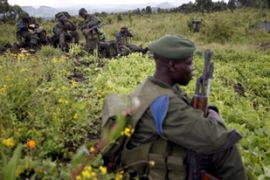DR Congo massacre uncovered
At least 300 people brutally killed over four-day period in December, rights group and UN say.

“The Makombo massacre is one of the worst ever committed by the LRA in its bloody 23-year history, yet it has gone unreported for months,” Anneke Van Woudenberg, HRW’s senior Africa researcher, said.
“The four-day rampage demonstrates that the LRA remains a serious threat to civilians and is not a spent force, as the Ugandan and Congolese governments claim.”
However, Obonyo Olweny, a former LRA spokesman, has told Al Jazeera that while the group is still active, it is not fighting civilians.
“I want to say categorically to the world that the LRA is not responsible for the killings going on in the [Democratic Republic of] Congo or the CAR [Central Africa Republic],” he said from Nairobi, Kenya, on Sunday.
“It is the UPD [the Ugandan armed forces] carrying out the killings – it is part of the government’s propaganda.”
‘Really brutal’
The UN said that its investigation had shown that the LRA had killed at least 290 people, perhaps more than 300, during the rampage and following LRA threats of such massacres the year before.
“The men were tied by the chest by the same rope and killed with wood sticks on the back of the head and neck – it was really brutal and fast,” Liliane Egounlety, who led the UN investigation, said.
| In video |
|
|
“They also used machetes. Many witnesses found it too hard to talk about.”
The UN said that at least 150 people had been abducted.
HRW’s investigation found that the LRA had made some of the 80 abducted children murder other children.
The LRA has a reputation of forcing children into becoming soldiers.
HRW said that the attacks in at least 10 villages were well planned, targeting men first, but also killing women and children.
The group said that the youngest person to die was a three-year-old girl who was burned to death, while at least 13 gangs and 23 children were killed.
Their document said that some people were killed by having their heads smashed with axes and heavy wooden sticks.
Regional problem
The LRA was formed in northern Uganda in the late-1980s as an opposition group.
In 2005, they were forced out of the East African country to the DRC, Central African Republic and south Sudan, from where they continued to launch cross-border attacks.
LRA fighters killed 1,200 people and kidnapped 1,400 others – including 630 children and more than 400 women – in the DRC during a 10-month period in 2008 and 2009, the UN has said.
| in depth | |||||||||||||||||||||||||||||
|
Van Woudenberg told Al Jazeera that the LRA had become a regional problem that needed action by the United Nations and African governments.
“What it does show is that it is high time for the Lord’s Resistance Army leaders to be arrested, for them to be brought to justice and these kind of atrocities to end,” she said.
“I think what is needed is some bold leadership, some really courageous steps taken by the governments of the region, by the United Nations peacekeeping forces to put together an regional strategy to end the terror of this group.”
A much-criticised UN mission remains in the east of DRC but is under pressure to leave the country by next year, when presidential polls are due to be held.
Monuc, the peacekeeping force, has about 22,000 soldiers in the region to keep peace in the face of Rwandan Hutu fighters.
“The difficulty and the challenge for United Nations peacekeepers that are stationed in that region, the Ugandan army and the Congolese army is that these men move through the bush at night; in many instances they dressed in military fatigues,” Al Jazeera’s Yvonne Ndege said from Nigeria.
“Many of the villagers are unsuspecting to begin with … initially these villagers were assisting the LRA fighters because they thought they were regular soldiers.”
Major challenges
Alan Doss, the UN special representative to DRC and head of Monuc, says the sheer size of the territory the peacekeepers are supposed to cover is one of the major challenges facing the mission.
“We have no soldiers in that area. At that time [of the massacre], we had focused on the major population centres, which are quite a distance away,” he told Al Jazeera on Sunday.
“They [the LRA fighters] are made up of small groups that move around.
“To deal with them effectively, we need to improve intelligence gathering, have additional air mobility [as there are no roads in many places], and be able to put special forces into these areas quickly to anticipate their moves and deal with them.”
Al Jazeera is not responsible for the content of external websites
